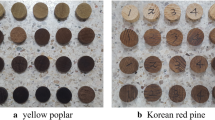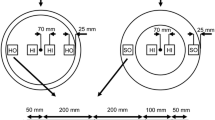Summary
The influence of drying methods on the permeability of red pine and eastern hemlock sapwood was investigated. Permeability was found to be reduced by normal drying procedures to only a small percentage of the green permeability. The reduction was more severe at higher drying temperatures; less severe but still very large at -18° C. Pit aspiration was shown to be responsible for the reduction. Replacing the sap with surfactant solutions and organic liquids and evaporating them revealed that pit aspiration occurred with surfactant solutions having surface tension values of less than 20 dynes/cm and did not occur with organic liquids having surface tension values as high as 44 dynes/cm. It is suggested that a critical factor in pit aspiration is the adhesion of the torus to the pit border, and the failure of the organic liquids to cause pit aspiration is due to their inability to promote adhesion between the torus and pit border.
Zusammenfassung
Der Einfluß verschiedener Trocknungsverfahren auf die Durchlässigkeit des Splintholzes bei Kiefer und Eastern Hemlock wurde untersucht. Es zeigte sich, daß bei Anwendung üblicher Trocknungsverfahren die Durchlässigkeit gegenüber jener des frischen Holzes sehr deutlich vermindert war. Höhere Trocknungstemperaturen setzten die Durchlässigkeit weit stärker herab; bei -18° C war die Verminderung etwas weniger stark, jedoch noch immer beträchtlich. Als Ursache für die Durchlässigkeitsverminderung wurde der Tüpfelverschluß gefunden. Beim Austausch des Zellsaftes gegen oberflächenaktive Lösungen bzw. gegen organische Flüssigkeiten und bei nachfolgender Verdampfung derselben ergab sich, daß die oberflächenaktiven Lösungen mit Oberflächenspannungswerten von höchstens 20 dyn/cm einen Tüpfelverschluß erzeugten, die organischen Lösungen mit Oberflächenspannungswerten bis zu 44 dyn/cm jedoch nicht. Es wird postuliert, daß beim Tüpfelverschluß das Haften des Torus am Tüpfelrand das Kriterium bildet; die Unfähigkeit bestimmter organischer Lösungen, einen Tüpfelverschluß zu bilden, ist darin zu sehen, daß sie die Adhäsion zwischen dem Torus und dem Tüpfelrand nicht zu fördern vermögen.
Similar content being viewed by others
References
Bramhall, G.: Longitudinal Permeability Within Douglas-fir (Pseudotsuga menziesii (Mirb.) Franco) Growth Increments. MS Thesis, University of British Columbia (1967).
Broughton, G., and J. P. Wang: The Mechanical Properties of Paper. Part III. TAPPI Vol. 38 (1955) No. 7, p. 412/415.
Comstock, G. L.: Longitudinal Permeability of Green Eastern Hemlock. For. Prod. J. Vol. 15 (1965) No. 10, p. 441/449.
—: Longitudinal Permeability of Wood to Gases and Nonswelling Liquids. For. Prod. J. Vol. 17 (1967) No. 10, p. 41/46.
Comstock, G. L.: Physical and Structural Aspects of the Longitudinal Permeability of Wood. Ph. D. Thesis, N. Y. S. U. College of Forestry, Syracuse (1968).
Côté, W. A., Jr., Z. Koran, and A. C. Day:Replica Techniques for Electron Microscopy of Wood and Paper. TAPPI Vol. 38 (1964) No. 8, p. 477/484.
Erickson, H. D., and R. J. Crawford: The Effects of Several Seasoning Methods on the Permeability of Wood to Liquids. Amer. Wood Pres. Assoc. Proc. (1959) p. 210/220.
—, and L. W. Rees: Effect of Several Chemicals on the Swelling and the Crushing Strength of Wood. J. Agr. Res. Vol. 60 (1940) No. 9 p. 593/603.
Griffin, G. J.: Bordered Pits in Douglas-fir: A Study of the Position of the Torus in Mountain and Lowland Specimens in Relation to Creosote Penetration. J. Forestry Vol. 17 (1919) No. 7, pp. 813/822.
—: Further Note on the Position of the Tori in Bordered Pits in Relation to Penetration of Preservatives. J.Forestry Vol. 22 (1924) No. 6, p. 82/83.
Hart, C. A., and R. J. Thomas: Mechanism of Bordered Pit Aspiration as Caused by Capillarity. For. Prod. J. Vol. 17 (1967) No. 11, p. 61/68.
Liese, W.: The Fine Structure of Bordered Pits in Softwoods. In Côté, W. A., Jr. (Ed.): Cellular Ultrastructure of Woody Plants. Syracuse Univ. Press. (1965) p. 271/290.
—, and J. Bauch: On the Closure of Bordered Pits in Conifers. Wood Science and Technology Vol. 1 (1967) No. 1, p. 1/13.
Nicholas, D. D., and R. J. Thomas: Ultrastructure of Bordered Pit Membrane in Loblolly Pine. For. Prod. J. Vol. 18 (1968) No. 1, p. 57/59.
Phillips, E. W. J.: Movement of Pit Membrane in Coniferous Woods with Special Reference to Preservative Treatment. Forestry Vol. 7 (1933) p. 109/120.
Stamm, A. J.: Wood and Cellulsoe Science. New York 1964: Ronald Press.
Thomas, R. J.: The Development and Ultrastructure of the Pits of Two Southern Yellow Pine Species. DF Thesis, Duke University (1967).
Thomas, R. J.: The Structure of the Pit Membranes in Longleaf Pine: An Electron Microscope Study. Amer. Wood Pres. Assoc.Proc. (1967).
—, and D. D. Nicholas: Pit Membrane Structure in Loblolly Pine as Influenced by Solvent Exchange Drying. For. Prod. J. Vol. 16 (1966) No. 3, p53/56.
Author information
Authors and Affiliations
Rights and permissions
About this article
Cite this article
Comstock, G.L., Côté, W.A. Factors affecting permeability and pit aspiration in coniferous sapwood. Wood Science and Technology 2, 279–291 (1968). https://doi.org/10.1007/BF00350274
Received:
Issue Date:
DOI: https://doi.org/10.1007/BF00350274




